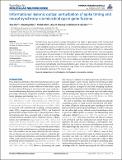| dc.contributor.author | Han, Xue | |
| dc.contributor.author | Qian, Xiaofeng | |
| dc.contributor.author | Stern, Patrick | |
| dc.contributor.author | Chuong, Amy S. | |
| dc.contributor.author | Boyden, Edward | |
| dc.date.accessioned | 2010-09-17T17:53:36Z | |
| dc.date.available | 2010-09-17T17:53:36Z | |
| dc.date.issued | 2009-07 | |
| dc.date.submitted | 2009-08 | |
| dc.identifier.issn | 1662-5099 | |
| dc.identifier.uri | http://hdl.handle.net/1721.1/58588 | |
| dc.description.abstract | Synchronous neural activity occurs throughout the brain in association with normal and pathological brain functions. Despite theoretical work exploring how such neural coordination might facilitate neural computation and be corrupted in disease states, it has proven difficult to test experimentally the causal role of synchrony in such phenomena. Attempts to manipulate neural synchrony often alter other features of neural activity such as firing rate. Here we evaluate a single gene which encodes for the blue-light gated cation channel channelrhodopsin-2 and the yellow-light driven chloride pump halorhodopsin from Natronobacterium pharaonis, linked by a ‘self-cleaving’ 2A peptide. This fusion enables proportional expression of both opsins, sensitizing neurons to being bi-directionally controlled with blue and yellow light, facilitating proportional optical spike insertion and deletion upon delivery of trains of precisely-timed blue and yellow light pulses. Such approaches may enable more detailed explorations of the causal role of specific features of the neural code. | en_US |
| dc.description.sponsorship | National Institutes of Health (U.S) (DP2 OD002002-01) | en_US |
| dc.description.sponsorship | National Science Foundation (U.S.) (0835878) | en_US |
| dc.description.sponsorship | National Science Foundation (U.S.) (0848804) | en_US |
| dc.description.sponsorship | McGovern Institute for Brain Research at MIT (Neurotechnology Award Program) | en_US |
| dc.description.sponsorship | United States. Dept. of Defense | en_US |
| dc.description.sponsorship | Alfred P. Sloan Foundation | en_US |
| dc.description.sponsorship | Jerry Burnett Foundation | en_US |
| dc.description.sponsorship | NARSAD (The Brain and Behavior Research Fund) | en_US |
| dc.description.sponsorship | Society for Neuroscience (Research Award for Innovation in Neuroscience) | en_US |
| dc.description.sponsorship | Massachusetts Institute of Technology. Media Laboratory | en_US |
| dc.description.sponsorship | Benesse Foundation | en_US |
| dc.description.sponsorship | Wallace H. Coulter Foundation | en_US |
| dc.description.sponsorship | Helen Hay Whitney Foundation | en_US |
| dc.description.sponsorship | National Institutes of Health (U.S) (1K99MH085944) | en_US |
| dc.language.iso | en_US | |
| dc.publisher | Frontiers Research Foundation | en_US |
| dc.relation.isversionof | http://dx.doi.org/10.3389/neuro.02.012.2009 | en_US |
| dc.rights | Article is made available in accordance with the publisher's policy and may be subject to US copyright law. Please refer to the publisher's site for terms of use. | en_US |
| dc.source | MIT Web Domain | en_US |
| dc.subject | optogenetics | en_US |
| dc.subject | channelrhodopsin-2 | en_US |
| dc.subject | halorhodopsin | en_US |
| dc.subject | fusion protein | en_US |
| dc.subject | synchrony | en_US |
| dc.title | Informational lesions: optical perturbation of spike timing and neural synchrony via microbial opsin gene fusions | en_US |
| dc.type | Article | en_US |
| dc.identifier.citation | Han X, Qian X, Stern P, Chuong AS and Boyden ES (2009). Informational lesions: optical perturbation of spike timing and neural synchrony via microbial opsin gene fusions. Front. Mol. Neurosci. 2:12. doi: 10.3389/neuro.02.012.2009 | en_US |
| dc.contributor.department | Massachusetts Institute of Technology. Department of Biological Engineering | en_US |
| dc.contributor.department | Massachusetts Institute of Technology. Department of Brain and Cognitive Sciences | en_US |
| dc.contributor.department | Massachusetts Institute of Technology. Department of Materials Science and Engineering | en_US |
| dc.contributor.department | Massachusetts Institute of Technology. Media Laboratory | en_US |
| dc.contributor.department | McGovern Institute for Brain Research at MIT | en_US |
| dc.contributor.department | Program in Media Arts and Sciences (Massachusetts Institute of Technology) | en_US |
| dc.contributor.department | Koch Institute for Integrative Cancer Research at MIT | en_US |
| dc.contributor.approver | Boyden, Edward S. | |
| dc.contributor.mitauthor | Han, Xue | |
| dc.contributor.mitauthor | Qian, Xiaofeng | |
| dc.contributor.mitauthor | Stern, Patrick | |
| dc.contributor.mitauthor | Chuong, Amy S. | |
| dc.contributor.mitauthor | Boyden, Edward Stuart | |
| dc.relation.journal | Frontiers in Molecular Neuroscience | en_US |
| dc.eprint.version | Final published version | en_US |
| dc.type.uri | http://purl.org/eprint/type/JournalArticle | en_US |
| eprint.status | http://purl.org/eprint/status/PeerReviewed | en_US |
| dspace.orderedauthors | Han, Xue | en |
| dc.identifier.orcid | https://orcid.org/0000-0002-8860-5914 | |
| dc.identifier.orcid | https://orcid.org/0000-0002-0419-3351 | |
| mit.license | PUBLISHER_POLICY | en_US |
| mit.metadata.status | Complete | |
